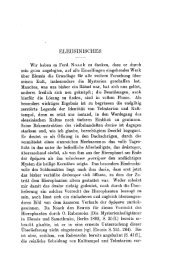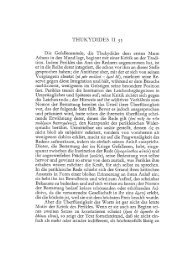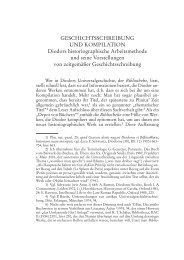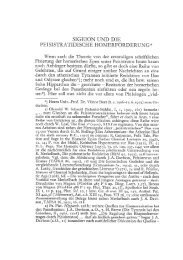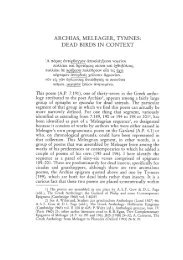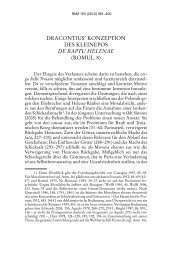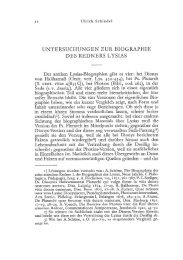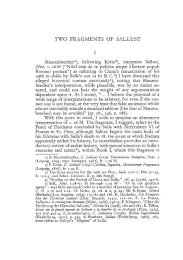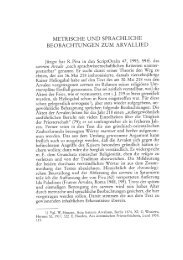the story of callisto in hesiod - Rheinisches Museum für Philologie
the story of callisto in hesiod - Rheinisches Museum für Philologie
the story of callisto in hesiod - Rheinisches Museum für Philologie
You also want an ePaper? Increase the reach of your titles
YUMPU automatically turns print PDFs into web optimized ePapers that Google loves.
122 William Sale<br />
THE STORY OF CALLISTO IN HESIOD<br />
The onIy thorough <strong>in</strong>vestigation <strong>in</strong>to <strong>the</strong> myth <strong>of</strong> Callisto<br />
was done <strong>in</strong> 1890 by Re<strong>in</strong>hold Franz, who sought, among o<strong>the</strong>r<br />
th<strong>in</strong>gs, to recover a form <strong>of</strong> <strong>the</strong> <strong>story</strong> which he could attribute<br />
to Hesiod 1). By "Hesiod" he meant <strong>the</strong> author <strong>of</strong> <strong>the</strong> Eoeae or<br />
Catalogue 0/ Women, "and <strong>the</strong> version <strong>of</strong> <strong>the</strong> myth which he<br />
considered Hesiodic is tailored to fit this work or works 2 );<br />
"that is, it does not end with <strong>the</strong> catasterism <strong>of</strong> Callisto, <strong>the</strong><br />
familiar scene <strong>in</strong> which Zeus changes her to <strong>the</strong> Great Bear.<br />
O<strong>the</strong>r scholars have been reluctant to sever <strong>the</strong> catasterism from<br />
<strong>the</strong> rest, and have <strong>the</strong>refore argued that <strong>the</strong> <strong>story</strong> belongs to <strong>the</strong><br />
Astronomy, ano<strong>the</strong>r part <strong>of</strong> <strong>the</strong> Hesiodic corpus 3). And <strong>in</strong><br />
Rzach's edition we f<strong>in</strong>d a ra<strong>the</strong>r detaiied account <strong>of</strong> Callisto<br />
assigned to <strong>the</strong> Astronomy as fragment 181 4 ). Recently J.<br />
Schwartz has taken an extremely skeptical position: Callisto<br />
was mentioned and her <strong>story</strong> perhaps told <strong>in</strong> <strong>the</strong> Catalogue,<br />
but we cannot recover this <strong>story</strong>; <strong>in</strong> <strong>the</strong> Astronomy she was<br />
not to be found, and <strong>the</strong> Great Bear was <strong>the</strong>re called Helice<br />
(Schwartz pp. 126n., 258). This view I f<strong>in</strong>d unwarrantabIy<br />
<strong>in</strong>credulous; <strong>the</strong> testimony conta<strong>in</strong>s absurdities and contradic-<br />
1) Re<strong>in</strong>hold Franz, nDe Callistus Fabula", Leipziger Studien 12, part 2<br />
(1890) 237-365.<br />
2) Regarded by Franz as two works (p. 345 n. 1); most modern scholars,<br />
correctly as it seems, regard <strong>the</strong> Eoeae as part <strong>of</strong> 01', more probably,<br />
identical with, <strong>the</strong> Catalogue. See J. Schwanz, Pseudo-Hesiodeia (Leiden<br />
1960) 13-32.<br />
3) Franz (p. 357) assigned this poem to a time between Hesiod and<br />
<strong>the</strong> fifth century. This date was attacked by Ernst Maass <strong>in</strong> Aratea (Philologische<br />
Untermchungen, ed. Kiessl<strong>in</strong>g-Wilamowitz, vol. 12 [Berl<strong>in</strong> 1892])<br />
268-272, follow<strong>in</strong>g K. O. Müller, Prolegomena zu e<strong>in</strong>er wissenschaftlichen<br />
Mythologie (Gött<strong>in</strong>gen 1825) 193. But <strong>the</strong> defense <strong>of</strong> an early date by<br />
Mart<strong>in</strong> Nilsson (Rhe<strong>in</strong>isches <strong>Museum</strong> 60 [19051 184) seems unobjectionable.<br />
For o<strong>the</strong>r views see Schwartz, pp. 249 and 259-60. Where convenient I will<br />
use <strong>the</strong> term nHesiod" to refer to <strong>the</strong> author <strong>of</strong> <strong>the</strong> Astronomy 01' <strong>the</strong><br />
Catalogue without imply<strong>in</strong>g that Hesiod 01' <strong>in</strong>deed <strong>the</strong> same authol' wrote<br />
both. 4) Aloisius Rzach, Hesiodi Carm<strong>in</strong>a (ed. maior Leipzig 1902; ed. m<strong>in</strong>or<br />
Leipzig 1913).
124 William Sale<br />
Vat. Vff.). The material <strong>in</strong> fragment 181 from <strong>the</strong> Epitome,<br />
Hyg<strong>in</strong>us and <strong>the</strong> Germanicus scholia descends ultimately from<br />
<strong>the</strong> section <strong>of</strong> Eratos<strong>the</strong>nes' book devoted to Ursa Major; <strong>the</strong><br />
quotation from Vaticanus 1087 (Marc. 444) descends from<br />
<strong>the</strong> section concern<strong>in</strong>g Arctophylax (though this quotation, as<br />
. we shall see, has been contam<strong>in</strong>ated with material from<br />
ano<strong>the</strong>r source). The question <strong>of</strong> <strong>the</strong> relation <strong>of</strong> <strong>the</strong>se witnesses<br />
to <strong>the</strong>ir orig<strong>in</strong>al is a much-vexed one; I have adopted <strong>the</strong> position<br />
<strong>of</strong> Jean Mart<strong>in</strong>, who splits <strong>the</strong> witnesses <strong>in</strong>to two camps,<br />
with Hyg<strong>in</strong>us on one side and all <strong>the</strong> o<strong>the</strong>rs on <strong>the</strong> o<strong>the</strong>r 7 ).<br />
Mart<strong>in</strong> shows that <strong>of</strong> <strong>the</strong>se Hyg<strong>in</strong>us is <strong>the</strong> most faithful (p. 124)<br />
and that <strong>in</strong> fact it is likely that he gives us a good picture <strong>of</strong><br />
<strong>the</strong> orig<strong>in</strong>al; s<strong>in</strong>ce Schwartz rejects, by implication, Hyg<strong>in</strong>us'<br />
worth it will be necessary later on for me to prove his value for<br />
what he says about Callisto. Our o<strong>the</strong>r witnesses were drawn at<br />
various times from ano<strong>the</strong>r tradition, whose <strong>in</strong>termediate<br />
source was a commentary to an edition <strong>of</strong> Aratus, and which<br />
occasionally received new material from outside <strong>the</strong> tradition.<br />
The <strong>story</strong> we can extract from this material must for<br />
purposes <strong>of</strong> analysis be arranged <strong>in</strong> sections; it runs as follows:<br />
181 A. T he Great Bear. Hesiod says that she was <strong>the</strong><br />
daughter <strong>of</strong> Lycaon and chose to spend her time with wild<br />
beasts <strong>in</strong> <strong>the</strong> mounta<strong>in</strong>s, toge<strong>the</strong>r withArtemis. Shewas ravished<br />
by Zeus but rema<strong>in</strong>ed <strong>in</strong> Artemis' company dissimulat<strong>in</strong>g her<br />
pregnant condition; eventually she was seen while bath<strong>in</strong>g and<br />
her secret discovered. Artemis <strong>in</strong> anger converted her toa bear,<br />
and <strong>in</strong> this form she gave birth to Arcas, named from Callisto's<br />
metamorphosis. (Hyg<strong>in</strong>us, <strong>the</strong> Germanicus scholia, <strong>the</strong> Epitome,<br />
<strong>the</strong> Aratus scholia and <strong>the</strong> scholia to Aratus Lat<strong>in</strong>us all report<br />
this; though only Hyg<strong>in</strong>us identifies <strong>the</strong> daughter <strong>of</strong> Lycaon as<br />
Callisto, it is highly probable, as I shall show later, that Era- .<br />
tos<strong>the</strong>nes also did so.)<br />
7) Mart<strong>in</strong>, Histoire 66 H. I am not conv<strong>in</strong>ced that Mart<strong>in</strong> is entirely<br />
justified <strong>in</strong> th<strong>in</strong>k<strong>in</strong>g that <strong>the</strong> ancestor <strong>of</strong> <strong>the</strong> Epitome necessarily occupied<br />
an earlier place <strong>in</strong> <strong>the</strong> tradition than <strong>the</strong> ancestor <strong>of</strong> <strong>the</strong> Aratus Lat<strong>in</strong>us<br />
and Vat gr 1087. My arguments are not, I th<strong>in</strong>k, <strong>in</strong> violent disharmony<br />
with Rehm's stemma (Frag. Vat. p. XXIV). It is <strong>of</strong> some importance to<br />
portions <strong>of</strong> my <strong>the</strong>sis that Hyg<strong>in</strong>us is <strong>the</strong> best reflection <strong>of</strong> <strong>the</strong> orig<strong>in</strong>al,<br />
though naturally his unsupported testimony cannot be accepted uncritically.<br />
It would not seriously damage my position if Eratos<strong>the</strong>nes himself were<br />
proved not to have been <strong>the</strong> ultimate source <strong>of</strong> <strong>the</strong>se witnesses, though it<br />
would be <strong>in</strong>convenient should it prove to have been someone utterly<br />
untrustworthy.
The <strong>story</strong> <strong>of</strong> Callisto <strong>in</strong> Hesiod 127<br />
The scholia to <strong>the</strong> Greek Aratus are here virtually identical<br />
with <strong>the</strong> Epitome and are <strong>the</strong>refore drawn from some descendant<br />
<strong>of</strong> y; this descendant has dropped <strong>the</strong> citation from Amphis<br />
and left <strong>the</strong> reader with <strong>the</strong> mislead<strong>in</strong>g impression that <strong>the</strong> <strong>story</strong><br />
after <strong>the</strong> birth <strong>of</strong> Arcas, 181 B, was taken from Hesiod. We<br />
cannot, <strong>the</strong>refore, attribute <strong>the</strong> <strong>story</strong> <strong>of</strong> 181 B to Hesiod or say<br />
that Eratos<strong>the</strong>nes did so.<br />
Rehm, however, feit that <strong>the</strong> epitomator must have had good<br />
reason to allow <strong>the</strong> reader to th<strong>in</strong>k that <strong>the</strong> rest <strong>of</strong> <strong>the</strong> <strong>story</strong><br />
was Hesiod's 9); and it would appear to be a poor poliey to let.<br />
<strong>the</strong> question <strong>of</strong> whe<strong>the</strong>r or not 181 B derives from Hesiod<br />
depend on so uncerta<strong>in</strong> a foundation as whe<strong>the</strong>r <strong>the</strong> Epitome<br />
or <strong>the</strong> Lat<strong>in</strong> tradition is a better source for Eratos<strong>the</strong>nes. The<br />
<strong>story</strong> <strong>of</strong> .181 Bitself, however, cries out its composite orig<strong>in</strong>;<br />
consider <strong>the</strong> follow<strong>in</strong>g curious details:<br />
1. Goa<strong>the</strong>rds are not at all <strong>the</strong> right SOft <strong>of</strong> people for<br />
captur<strong>in</strong>g bears, though <strong>the</strong>y are apt for f<strong>in</strong>d<strong>in</strong>g and br<strong>in</strong>g<strong>in</strong>g<br />
up homeless children.<br />
2. What law is Callisto ignorant <strong>of</strong>? Later, <strong>in</strong> <strong>the</strong> <strong>story</strong> <strong>of</strong><br />
Arctophylax, we will be told: louis Lycaei templum, quo ei qui<br />
accessisset mors poena erat Arcadum lege (Hyg<strong>in</strong>us). But why<br />
are we told noth<strong>in</strong>g now?<br />
3. It seems highly unlikely that <strong>the</strong>re was a law aga<strong>in</strong>st<br />
bears go<strong>in</strong>g <strong>in</strong>to <strong>the</strong> abaton, but that is just what Eratos<strong>the</strong>nes<br />
implies. Pausanias says that men were denied entrance, and that<br />
"when a beast takes refuge <strong>in</strong> <strong>the</strong> prec<strong>in</strong>ct, <strong>the</strong> hunter will not<br />
break <strong>in</strong> along with it" (8.36.6) 10). .<br />
4. Why was Arcas pursu<strong>in</strong>g Callisto? Were <strong>the</strong>y not<br />
brought to Lycaon toge<strong>the</strong>r, and had <strong>the</strong>y not lived <strong>the</strong>re for<br />
some years, long enoJ,lgh <strong>in</strong> fact for Arcas to grow to hunt<strong>in</strong>g<br />
age?<br />
Gerrnanicus scholia cannot possibly derive <strong>the</strong>ir material on <strong>the</strong> Great Bear<br />
from Hyg<strong>in</strong>us, s<strong>in</strong>ce for Hyg<strong>in</strong>us' misread<strong>in</strong>g <strong>of</strong> <strong>the</strong> Greek word a!ltOAUlV a5<br />
Aetolorum <strong>the</strong>y give, with reasonable correctness, pastoribus.<br />
9) Albert Rehm, Mythographische Untersuchungen über griechische<br />
Sternsagen (Munich 1896) 37 H. - abbreviated Myth. Unters. Emanuel<br />
GürkoH's criticisms <strong>of</strong> this work <strong>in</strong> his dissertation Die Katasterismen des<br />
Eratos<strong>the</strong>nes (S<strong>of</strong>ia 1931) 76-83 and 89-94 are generally sound.<br />
10) Cf. also Plutarch Greek Questions 39, where it is said that anyone<br />
(human) who entered <strong>the</strong> abaton know<strong>in</strong>g <strong>the</strong> law was put to death;<br />
o<strong>the</strong>rwise <strong>the</strong>y were "sent to Eleu<strong>the</strong>rae", whatever that means. If we<br />
believe Plutarch, Callisto was doubly <strong>in</strong>nocent, both for be<strong>in</strong>g a bear and<br />
for not know<strong>in</strong>g <strong>the</strong> law.
The <strong>story</strong> <strong>of</strong> Callisto <strong>in</strong> Hesiod 129<br />
[I have followed Hyg<strong>in</strong>us throughout except where he<br />
obviously blunders, omitt<strong>in</strong>g <strong>the</strong>refore <strong>the</strong> testimony <strong>of</strong><br />
181 C because, as will appear later, I do not consider Eratos<strong>the</strong>nes<br />
responsible for this fragment.]<br />
The first part <strong>of</strong> this tale is <strong>the</strong> <strong>story</strong> <strong>of</strong> Lycaon; we have had<br />
a glimpse <strong>of</strong> it <strong>in</strong> Vat gr 1087 (which however mentions Hesiod<br />
and gives Lycaon a different motive for cutt<strong>in</strong>g up <strong>the</strong> child).<br />
Comb<strong>in</strong>ed ra<strong>the</strong>r awkwardly with this is <strong>the</strong> <strong>story</strong> <strong>of</strong> Arcas,<br />
part <strong>of</strong> which we have just disentangled from 181 B.<br />
If now we ask how it is that Zeus happened to pick<br />
goa<strong>the</strong>rds to br<strong>in</strong>g up Arcas, and if we reflect that <strong>in</strong> 181 B it<br />
was goa<strong>the</strong>rds who first found Arcas <strong>in</strong> <strong>the</strong> woods, it will be<br />
hard to avoid <strong>the</strong> conclusion that beh<strong>in</strong>d both 181 Band <strong>the</strong><br />
<strong>story</strong> <strong>of</strong> Arctophylax <strong>the</strong>re lurks a very simple tale: Arcas after<br />
birth was found and brought up by goa<strong>the</strong>rds; when grown to<br />
manhood he encountered his mo<strong>the</strong>r <strong>in</strong> <strong>the</strong> woods, pursued her<br />
<strong>in</strong>to <strong>the</strong> abaton and was about to be killed when Zeus changed<br />
both hirn and his mo<strong>the</strong>r ioto constellations. (This I shall call<br />
<strong>the</strong> basic <strong>story</strong> <strong>of</strong> Arcas, reserv<strong>in</strong>g <strong>the</strong> termLycaon-Arctophylax<br />
for <strong>the</strong> composite account.) Someone who was anxious to<br />
comb<strong>in</strong>e this <strong>story</strong> with <strong>the</strong> tale <strong>of</strong> Lycaon decided to make<br />
Arcas Lycaon's victim. To do this, he imag<strong>in</strong>ed that <strong>the</strong><br />
goa<strong>the</strong>rds brought Arcas to Lycaon after <strong>the</strong>y found hirn, and<br />
<strong>the</strong>n got hirn back aga<strong>in</strong> after he was restored by Zeus. Now<br />
<strong>the</strong> only one <strong>of</strong> our many sources for <strong>the</strong> <strong>story</strong> <strong>of</strong> Lycaon who<br />
says that Arcas was <strong>the</strong> victim is Eratos<strong>the</strong>nes 12). It seems<br />
<strong>the</strong>refore natural enough to say that Eratos<strong>the</strong>nes was <strong>the</strong> first<br />
to put toge<strong>the</strong>r <strong>the</strong> stories <strong>of</strong> Arcas and Lycaon <strong>in</strong> this way <br />
that he created <strong>the</strong> Lycaon-Arctophylax version.<br />
Where Eratos<strong>the</strong>nes got <strong>the</strong> stories <strong>of</strong> Arcas and <strong>of</strong> Lycaon<br />
cannot be certa<strong>in</strong>ly known, but one objection must be forestal<br />
Ied. If Eratos<strong>the</strong>nes were responsible for 181 C, that would mean<br />
that Hesiod was his source for <strong>the</strong> <strong>story</strong> <strong>of</strong> Lycaon. This would<br />
not mean that Hesiod was responsible for Lycaon-Arctophylax,<br />
12) Cf. also Franz 308-9. Mak<strong>in</strong>g Arcas <strong>the</strong> victim does not seem<br />
to give <strong>the</strong> tale any particular literary po<strong>in</strong>t. The situation would be<br />
different if it were feit desirable to have Zeus devour his own son, but so<br />
far as I know no ancient sour.:e could quite br<strong>in</strong>g himself to allot Lycaon<br />
such adesire. Ir should be noted that our sources not only ord<strong>in</strong>arily fail<br />
to make Arcas Lycaon's victim, but keep <strong>the</strong> stories <strong>of</strong> Callisto-Arcas and<br />
Lycaon entirely separate.
130 William Sale<br />
for 181 C nowhere implies that Arcas was <strong>the</strong> victim. It would<br />
still be Eratos<strong>the</strong>nes who made <strong>the</strong> composite version. Actually,<br />
I th<strong>in</strong>k it more probable, as I shall expla<strong>in</strong> below, that we do<br />
not owe 181 C to Eratos<strong>the</strong>nes, though it not only sterns from<br />
Hesiod but, <strong>in</strong> my op<strong>in</strong>ion, from <strong>the</strong> same poem as 181 A, which<br />
we do owe to Eratos<strong>the</strong>nes. Eratos<strong>the</strong>nes will have chosen to<br />
. ignore <strong>the</strong> part which told how Lycaon served human flesh to<br />
Zeus <strong>in</strong> revenge for bis daughter's seduction, because he wanted<br />
to identify <strong>the</strong> child with Arcas and was unwill<strong>in</strong>g to leave<br />
<strong>the</strong> impression that Hesiod made this identification. So he<br />
changed <strong>the</strong> <strong>story</strong> <strong>of</strong> Lycaon slightly: he made Arcas <strong>the</strong> victim,<br />
and said that Lycaon's motive was to test Zeus' div<strong>in</strong>ity (this<br />
detail may have come from some version, not Hesiodic, <strong>of</strong> <strong>the</strong><br />
<strong>story</strong> <strong>of</strong> Lycaon).<br />
The question now rema<strong>in</strong><strong>in</strong>g is whe<strong>the</strong>r 181 Bwas composed<br />
before or after <strong>the</strong> Lycaon-Arctophylax version. If it was<br />
before, <strong>the</strong>n we naturally suppose that <strong>the</strong> author <strong>of</strong> 181 B put<br />
toge<strong>the</strong>r no more than <strong>the</strong> tale <strong>of</strong> Callisto and <strong>the</strong> basic <strong>story</strong><br />
oE Arcas. But if so, why did he say that.<strong>the</strong> goa<strong>the</strong>rds, after<br />
f<strong>in</strong>d<strong>in</strong>g Arcas, brought hirn to Lycaon? This event has no place<br />
<strong>in</strong> Arcas' basic <strong>story</strong>, <strong>in</strong> which <strong>the</strong> goa<strong>the</strong>rds f<strong>in</strong>d hirn and<br />
br<strong>in</strong>g hirn up. And it has no comprehensible role <strong>in</strong> 181 B, unless<br />
Arcas is brought to Lycaon so that Lycaon can cut hirn up. But<br />
that implies that 181 B was composed after <strong>the</strong> Lycaorr-Arctophylax<br />
version, that <strong>the</strong> author had <strong>the</strong> goa<strong>the</strong>rds br<strong>in</strong>g Arcas<br />
to Lycaon because he was later go<strong>in</strong>g to tell a <strong>story</strong> <strong>in</strong> which<br />
this event played an important part.<br />
On <strong>the</strong> reasonable <strong>the</strong>ory that it was Eratos<strong>the</strong>nes who<br />
was responsible for <strong>the</strong> Lycaon-Arctophylax version, we can<br />
only conclude that he was responsible for 181 B too. But thc<br />
argument need not depend on this <strong>the</strong>ory. We have already<br />
seen that no poet could have told all that we f<strong>in</strong>d <strong>in</strong> fragment<br />
181 A-181 C (toge<strong>the</strong>r with what we must supply to complete<br />
<strong>the</strong> tale) - that is, <strong>the</strong> comb<strong>in</strong>ed stories <strong>of</strong> Callisto and Lycaon<br />
ArctOphylax - as a cont<strong>in</strong>uous narrative, for it would be too<br />
absurd. And we have just seen that 181 B was composed to be<br />
part <strong>of</strong> just such a comb<strong>in</strong>ed version. It follows <strong>in</strong>evitably that<br />
we cannot derive 181 B from <strong>the</strong> poetry <strong>of</strong> Hesiod. And it certa<strong>in</strong>ly<br />
seems reasonable to attribute <strong>the</strong> present form <strong>of</strong> 181 B<br />
to Eratos<strong>the</strong>nes, who <strong>in</strong> follow<strong>in</strong>g his catalogue arrangement
The <strong>story</strong> <strong>of</strong> Callisto <strong>in</strong> Hesiod 133<br />
<strong>the</strong> identity <strong>of</strong> Lycaon's victim is not small 16 ). Many sources<br />
leave <strong>the</strong> child nameless, <strong>in</strong>clud<strong>in</strong>g <strong>the</strong> Thebaid scholiast, <strong>the</strong><br />
only source besides z, so far as I know, which attributes this<br />
motive to Lycaon17). Hence <strong>the</strong>re is no real objection to our<br />
deriv<strong>in</strong>g this fragment from Hesiod. But before we can decide<br />
whe<strong>the</strong>r or not it comes from <strong>the</strong> Astronomy, we must discuss<br />
<strong>the</strong> status <strong>of</strong> fragment 181 A.<br />
Franz, who on ra<strong>the</strong>r arbitrary grounds contested <strong>the</strong><br />
attribution <strong>of</strong> 181 B to Hesiod, feIt that 181 A was <strong>the</strong> beg<strong>in</strong>n<strong>in</strong>g<br />
<strong>of</strong> a <strong>story</strong> <strong>of</strong> Callisto from <strong>the</strong> Catalogue or Eoeae which<br />
ended with Hermes tak<strong>in</strong>g Arcas to his mo<strong>the</strong>r Maia to nourish<br />
on Cyllene, and Callisto to Mt. Lycaeus 18). His assignment <strong>of</strong><br />
such an end<strong>in</strong>g to Hesiod is altoge<strong>the</strong>r arbitrary and unconv<strong>in</strong>c<strong>in</strong>g,<br />
but scholars have generally cont<strong>in</strong>ued to believe <strong>in</strong> <strong>the</strong><br />
au<strong>the</strong>nticity <strong>of</strong> 181 A itself. J. Schwartz, however, has recently<br />
ma<strong>in</strong>ta<strong>in</strong>ed that <strong>the</strong> attribution to Hesiod orig<strong>in</strong>ally belonged<br />
only to a small part <strong>of</strong> 181 A, <strong>the</strong> statement that Callisto liked<br />
to hunt with Artemis, and that <strong>the</strong> name "Hesiod" later found<br />
its way from this sentence to <strong>the</strong> beg<strong>in</strong>n<strong>in</strong>g <strong>of</strong> <strong>the</strong> passage where<br />
it now stands <strong>in</strong> all our witnesses 19). Callisto, whose <strong>story</strong> we<br />
16) The victims <strong>of</strong> Lycaon are brought toge<strong>the</strong>r by O. Gruppe,<br />
GriedJisdJe Mythologie und Religion (Munich 1906) p. 920 n. 4.<br />
17) Lactantius Placidus, ed. Ricardus ]ahnke (Leipzig, Teubner, 1898)<br />
on Statius Thebaid 7. 414: dolore stupratae a laue filiae deos (?) humanarum<br />
carniuon cibis uiolauit. Lactantius actually speaks <strong>of</strong> Helice ra<strong>the</strong>r than<br />
Callisto, apparently substitut<strong>in</strong>g <strong>the</strong> name carelessly.<br />
18) Franz, 266 H. His argument is that Hesiod could not have ended<br />
his <strong>story</strong> with <strong>the</strong> catasterism, s<strong>in</strong>ce catasterisms are <strong>in</strong> general an Alexandrian<br />
<strong>in</strong>novation and s<strong>in</strong>ce Euripides showed no knowledge <strong>of</strong> it; a Theocritus<br />
scholion (1. 123) gives us <strong>the</strong> only o<strong>the</strong>r end<strong>in</strong>g we hear about whidl<br />
Franz can/it on to <strong>the</strong> Hesiodic <strong>story</strong>, hence it gives us what Hesiod said.<br />
Pre-Alexandrian catasrerisms are <strong>of</strong> course known (Schol. P<strong>in</strong>dar Nem. 2. 16),<br />
and <strong>the</strong> rest <strong>of</strong> Franz' argument is disastrously circular. On pav;e 359 he<br />
says he has proved that Callimachus <strong>in</strong>vented <strong>the</strong> catasterism <strong>of</strong> Callisro,<br />
so that it could not have been part <strong>of</strong> <strong>the</strong> Hesiodic Astronomy; on page 297<br />
he says that Callimadlus must have <strong>in</strong>vented <strong>the</strong> catasterism because, among<br />
o<strong>the</strong>r th<strong>in</strong>gs, it was not <strong>in</strong> Hesiod; on page 265 he says that Hesiod cannot<br />
have ended with <strong>the</strong> catasterism because this was <strong>the</strong> sort <strong>of</strong> th<strong>in</strong>g that<br />
<strong>the</strong> Alexandrians did.<br />
19) "Sa legende (Callisto's) dans la BibI. Apoll. (III, 100sq) diHhe<br />
entierement de celle de l'Epitome d'Eraros<strong>the</strong>ne, sauf sur un po<strong>in</strong>t: Callisro<br />
aime a chasser avec Artemis. F<strong>in</strong>alement la mention d'Hesiode ne s'appliquerait<br />
qu'a ce dernier detail" (p. 126). Actually <strong>the</strong>re is more agreement<br />
than this; <strong>in</strong> both accounts Zeus sleeps with Callisto, she becomes a bear,<br />
and she give, birth ro a dlild named Arcas.
134 William Sale<br />
cannot recover, orig<strong>in</strong>ally figured <strong>in</strong> <strong>the</strong> Catalogue, and <strong>the</strong><br />
Astronomy knew <strong>the</strong> Great Bear as Helice.<br />
Schwartz' view, to beg<strong>in</strong> with, contends with ano<strong>the</strong>r<br />
position <strong>of</strong> his own, that it was Hyg<strong>in</strong>us and not his source<br />
who identified <strong>the</strong> daughter <strong>of</strong> Lycaon with Callist0 20 ). Now<br />
this source is supposed by Schwartz to descend from, or to be<br />
identical with, a document, let us call it N, which attributed<br />
<strong>the</strong> <strong>in</strong>formation that <strong>the</strong> daughter <strong>of</strong> Lycaon liked to hunt with<br />
Artemis to Hesiod. How do we know that <strong>the</strong> attribution<br />
applied to just this <strong>in</strong>formation? Because, says Schwartz, this<br />
is <strong>the</strong> <strong>in</strong>formation that N shares with [Apollodorus] Biblio<strong>the</strong>ke<br />
3. 8.2. From <strong>the</strong> latter we leam that Callisto, accord<strong>in</strong>g to<br />
Hesiod, liked to hunt with Artemis; we <strong>in</strong>fer that when N said<br />
that <strong>the</strong> daughter <strong>of</strong> Lycaon liked to hunt with Artemis, it<br />
owed, and attributed, this <strong>in</strong>formation to Hesiod. But how can<br />
we make such an <strong>in</strong>ference unless, <strong>in</strong> N itself, <strong>the</strong> daughter <strong>of</strong><br />
Lycaon was Callisto? How can Biblio<strong>the</strong>ke 3.8.2, which is<br />
about Callisto, tell us anyth<strong>in</strong>g about N unless N is about<br />
Callisto too?<br />
In fact nei<strong>the</strong>r <strong>of</strong> Schwartz' views seems to me correct. He<br />
makes no effort to reconstruct <strong>the</strong> source, <strong>the</strong> book which !<br />
consider to have been successfully assigned to Eratos<strong>the</strong>nes, and<br />
to expla<strong>in</strong> why, if Hesiod's name was not at <strong>the</strong> beg<strong>in</strong>n<strong>in</strong>g <strong>of</strong><br />
<strong>the</strong> <strong>story</strong> <strong>of</strong> <strong>the</strong> Great Bear <strong>in</strong> this source, all our witnesses<br />
agree <strong>in</strong> putt<strong>in</strong>g it <strong>the</strong>re; or why, if it was <strong>the</strong>re, we arewrong<br />
<strong>in</strong> say<strong>in</strong>g that it was Eratos<strong>the</strong>nes whoput it <strong>the</strong>re. And Eratos<strong>the</strong>nes'<br />
testimony ought to be fairly reliable. Schwartz po<strong>in</strong>ts<br />
to <strong>the</strong> fact that some <strong>of</strong> our Eratos<strong>the</strong>nes witnesses make<br />
erroneous attributions <strong>in</strong> <strong>the</strong> stories <strong>of</strong> <strong>the</strong> Ram and Orion, and<br />
so <strong>the</strong>y do; one <strong>of</strong> <strong>the</strong> Germanicus scholia br<strong>in</strong>gs <strong>the</strong> names <strong>of</strong><br />
Hesiod and Pherecydes to <strong>the</strong> head <strong>of</strong> <strong>the</strong> catasterism <strong>of</strong> <strong>the</strong><br />
Ram, where <strong>the</strong>y do not belong, and all <strong>the</strong> witnesses except<br />
Hyg<strong>in</strong>us attribute too much <strong>of</strong> <strong>the</strong> <strong>story</strong> <strong>of</strong> Orion to Hesiod<br />
(Schwartz 122-4). And we have seen many <strong>of</strong> <strong>the</strong>m do <strong>the</strong> same<br />
th<strong>in</strong>g with Callisto. But <strong>in</strong> every case, <strong>the</strong> reliability <strong>of</strong> Hyg<strong>in</strong>us<br />
is upheld, and <strong>in</strong> <strong>the</strong> case <strong>of</strong> Orion Schwartz <strong>in</strong>sists upon it.<br />
quite rightly. Hyg<strong>in</strong>us' fault, when he cites Hesiod, is to imply<br />
that Hesiod identified whatever mythological figure he is talk<strong>in</strong>g<br />
about with <strong>the</strong> constellation; thus: Hane (Virg<strong>in</strong>em) Hesio-<br />
20) »'Callisto nom<strong>in</strong>e' a ehe ajoute pour 'eclairer' le texte par Hyg<strong>in</strong>"<br />
(p. 126). Schwartz ignores <strong>the</strong> fact that Hyg<strong>in</strong>us calls her Callisto later <strong>in</strong><br />
<strong>the</strong> <strong>story</strong>.
The <strong>story</strong> <strong>of</strong> Callisto <strong>in</strong> Hesiod 135<br />
dus louis et Themidis filiam dixit, clearly a reference to<br />
Theogony 901-2 and Opera 256, though nei<strong>the</strong>r place <strong>of</strong> course<br />
says a word about Virgo; <strong>the</strong>y concern Dike, who wa's later<br />
identified with Virgo 21). Hence when he says that Hesiod<br />
identified <strong>the</strong> constellation <strong>of</strong> <strong>the</strong> Ram with <strong>the</strong> ram with <strong>the</strong><br />
golden fleece, we can only conclude, and Schwartz does conclude,<br />
that Hesiod spoke <strong>of</strong> <strong>the</strong> ram with <strong>the</strong> golden fleece but<br />
did not necessarily (<strong>in</strong> this case surely not) identify it with <strong>the</strong><br />
constellation 22). And so with Callrsto, when Hyg<strong>in</strong>us says that<br />
Hesiod called <strong>the</strong> Great Bear Callisto, we ought not necessarily<br />
to believe hirn, but we have no reason to reject whatever else<br />
Hyg<strong>in</strong>us attributes to Hesiod. And <strong>the</strong> fact that all <strong>the</strong> o<strong>the</strong>r<br />
witnesses support Hyg<strong>in</strong>us <strong>in</strong> assign<strong>in</strong>g this <strong>story</strong> to Hesiod is<br />
not entirely negligible.<br />
Hyg<strong>in</strong>us is not, however, confirmed by <strong>the</strong>se witnesses <strong>in</strong><br />
his statement that <strong>the</strong> daughter <strong>of</strong> Lycaon was named Callisto.<br />
We will see <strong>in</strong> <strong>the</strong> case <strong>of</strong> Orion that when he and <strong>the</strong> o<strong>the</strong>r<br />
witnesses part company he alone can be trusted, and here it is<br />
prima facie likely that <strong>the</strong> same th<strong>in</strong>g is true. The o<strong>the</strong>r witnesses<br />
seem to be derived from a commentary on an edition <strong>of</strong><br />
Aratus (Mart<strong>in</strong> p. 71), for which <strong>the</strong> identification <strong>of</strong> <strong>the</strong> Great<br />
Bear with Callisto is particulary embarrass<strong>in</strong>g, s<strong>in</strong>ce Aratus<br />
hirnself calls her Helice. But <strong>in</strong> order to decide def<strong>in</strong>itely which<br />
witness is more reliable here, we must raise two questions:<br />
what is <strong>the</strong> <strong>in</strong>herent likelihood <strong>of</strong> Hesiod's hav<strong>in</strong>g called Callisto<br />
<strong>the</strong> daughter <strong>of</strong> Lycaon, and <strong>of</strong> Hyg<strong>in</strong>us' hav<strong>in</strong>g added <strong>the</strong><br />
reference to Callisto to what he took from Eratos<strong>the</strong>nes?<br />
Apollodorus 3.8.2 (fragment 181 D) says that Eumelos and<br />
certa<strong>in</strong> o<strong>the</strong>rs said that Lycaon had a daughter named Callisto,<br />
while Hesiod makes her one <strong>of</strong> <strong>the</strong> nymphs. At first sight this<br />
seems to settle <strong>the</strong> question - Hesiod did not make Callisto <strong>the</strong><br />
daughter <strong>of</strong> Lycaon. But Robert long ago po<strong>in</strong>ted out that<br />
Apollodorus and Eratos<strong>the</strong>nes could have got <strong>the</strong>ir <strong>in</strong>formation<br />
21) Robert decided. I th<strong>in</strong>k correctly, that <strong>the</strong> reference to <strong>the</strong> Theogony<br />
<strong>in</strong> <strong>the</strong> Epitome was not <strong>in</strong> Eratos<strong>the</strong>nes. In <strong>the</strong> scholia to Aratus<br />
Lat<strong>in</strong>us (and <strong>the</strong>refore presumably <strong>in</strong> z) both <strong>the</strong> Theogony and Works and<br />
Days are mentioned. The scholia to Aratus hirnself are here drawn from<br />
ano<strong>the</strong>r source, though <strong>the</strong>y mention (and quote from) <strong>the</strong> Works and Days.<br />
It is possible that y (<strong>the</strong> common source <strong>of</strong> <strong>the</strong> Epitome and z) had both<br />
references and that <strong>the</strong> Epitome dropped one <strong>of</strong> <strong>the</strong>m.<br />
22) Schol. Aratus 225 is surely right <strong>in</strong> say<strong>in</strong>g that it was Eratos<strong>the</strong>nes<br />
hirnself who identified· Ram and constellation.
The <strong>story</strong> <strong>of</strong> Callisto <strong>in</strong> Hesiod 139<br />
namely Aristomachus, who at least made his putative fa<strong>the</strong>r a<br />
Theban; Hesiod apparently thought that Orion was a Cretan.<br />
The o<strong>the</strong>r witnesses <strong>of</strong> Eratos<strong>the</strong>nes omit <strong>the</strong> word Thebis <strong>in</strong><br />
<strong>the</strong> sentence hic dicitur T hebis Chium uenisse. But this happened<br />
because <strong>the</strong>ir parent dropped it when it left out <strong>the</strong> <strong>in</strong>terrupt<strong>in</strong>g<br />
reference to P<strong>in</strong>dar and Aristomachus and <strong>the</strong> <strong>story</strong> <strong>of</strong> Orion's<br />
birth from <strong>the</strong> ur<strong>in</strong>e <strong>of</strong> <strong>the</strong> gods 26). Fragment 182B has <strong>the</strong>refore<br />
been assigned to Hesiod for <strong>the</strong> same wrong reason as<br />
181 B: <strong>the</strong> poorer witnesses to Eratos<strong>the</strong>nes have omitted an<br />
important <strong>in</strong>terven<strong>in</strong>g reference. And here too <strong>the</strong>re is corroboration;<br />
<strong>the</strong> Oenopion <strong>story</strong> fits <strong>the</strong> version quoted by Diodorus<br />
very badly. It makes no mention <strong>of</strong> <strong>the</strong> fill<strong>in</strong>g <strong>in</strong> <strong>of</strong> <strong>the</strong> straits<br />
<strong>of</strong> Mess<strong>in</strong>a or <strong>of</strong> Orion's retir<strong>in</strong>g to Euboea; on <strong>the</strong> contrary,<br />
he goes to Crete from Chios and <strong>the</strong>re becomes astar. Accord<strong>in</strong>g<br />
to Diodorus, Orion was reckoned among <strong>the</strong> stars because<br />
<strong>of</strong> hi'S farne; accord<strong>in</strong>g to Eratos<strong>the</strong>nes, he became a star because<br />
<strong>of</strong> his manl<strong>in</strong>ess and at <strong>the</strong> behest <strong>of</strong> Artemis and Leto. Hence<br />
<strong>the</strong> Oenopion <strong>story</strong>, 182B, should be struck from <strong>the</strong> fragments<br />
<strong>of</strong> Hesiod.<br />
Orion's <strong>story</strong>, <strong>the</strong>refore, cannot safely be assigned to <strong>the</strong><br />
Astronomy. On <strong>the</strong> o<strong>the</strong>r hand, <strong>the</strong> attestation <strong>of</strong> <strong>the</strong> fragments<br />
concern<strong>in</strong>g <strong>the</strong> Pleiades and Hyades, 177-80, is secure,<br />
especially s<strong>in</strong>ce <strong>the</strong> discovery <strong>of</strong> <strong>the</strong> Hebrew fragment concern<strong>in</strong>g<br />
<strong>the</strong> Pleiades 27). But we cannot say that <strong>the</strong> Astronomy<br />
conta<strong>in</strong>ed <strong>the</strong> catasterism <strong>of</strong> <strong>the</strong> Pleiades, though <strong>the</strong> case <strong>of</strong><br />
<strong>the</strong> Hyades is somewhat more encourag<strong>in</strong>g. We know <strong>the</strong><br />
poem conta<strong>in</strong>ed l<strong>in</strong>es which make <strong>the</strong> Hyades "Nymphs like <strong>the</strong><br />
Graces", and give <strong>the</strong>m <strong>the</strong> qualities <strong>of</strong> earthly females: Phaeo<br />
is desirable, Eudora has a flow<strong>in</strong>g robe (fragment 180). Now<br />
it is impossible that an astronomical poem should speak <strong>of</strong> <strong>the</strong><br />
nymphs Hyades and not connect <strong>the</strong>m with <strong>the</strong> stars; yet <strong>the</strong><br />
Astronomy must have spoken <strong>of</strong> nymphs, for it is hard to see<br />
how a star can be called a nymph like <strong>the</strong> Graces or be said to<br />
wear a flow<strong>in</strong>g robe. The fragment certa<strong>in</strong>ly suggests that <strong>the</strong><br />
26) The smolia to Germanicus and to Aratus Lat<strong>in</strong>us put <strong>the</strong> material<br />
from Aristomamus at thc end, whim means that it was <strong>in</strong> x, <strong>the</strong> common<br />
source <strong>of</strong> all witnesses except Hyg<strong>in</strong>us. It persisted at <strong>the</strong> end <strong>in</strong> y and z,<br />
but was ignored by <strong>the</strong> Epitomator and <strong>the</strong> Aratus smolia (or <strong>the</strong>ir common<br />
source).<br />
27) See H. J. Kraus, H. Smmidt, W. Kranz, .E<strong>in</strong> neues Hesiodfragment",<br />
Rhe<strong>in</strong>isches <strong>Museum</strong>, N. F. 95,3 (1952) 217-228.
HO William Sale<br />
poem mentioned both nymphs and stars and drew a connection<br />
between <strong>the</strong>m; possibly <strong>the</strong>re was no more than a statement<br />
that <strong>the</strong> stars were a memorial to <strong>the</strong> nymphs, possibly <strong>the</strong>re<br />
was a ttue catasterism.<br />
The state <strong>of</strong> <strong>the</strong> evidence is <strong>the</strong>refore this: <strong>the</strong> Astronomy<br />
may weIl have had catasterisms, perhaps <strong>in</strong> a rudimentary form.<br />
Whe<strong>the</strong>r it told any long mythical narrative - <strong>in</strong> particular,<br />
<strong>the</strong> myth <strong>of</strong> Orion - we cannot say. We have <strong>the</strong>refore no<br />
good parallels to urge us to assign 181 A to <strong>the</strong> Astronomy,<br />
no good reason to assert that it does not belong <strong>the</strong>re. Tbe<br />
Astronomy probably mentioned <strong>the</strong> Bear: it may have called<br />
it that, or <strong>the</strong> Wa<strong>in</strong>, or Helice, or Callisto; it may or may not<br />
have told a <strong>story</strong> about it. What we can say <strong>of</strong> fragment 181 A,<br />
on <strong>the</strong> o<strong>the</strong>r hand, is that it is Hesiodic, and it may or may<br />
not have cont<strong>in</strong>ued with an end<strong>in</strong>g identify<strong>in</strong>g Callisto with<br />
Ursa Major. We can also say that it is <strong>in</strong>compatible with 181 D,<br />
which implies that Callisto was not Lycaon's daughter:<br />
Eumelus and certa<strong>in</strong> o<strong>the</strong>rs say that Lycaon also ha.d a<br />
daughter Callisto; but Hesiod says that she was one <strong>of</strong> <strong>the</strong><br />
nymphs.<br />
There is no reason to doubt <strong>the</strong> trustworth<strong>in</strong>ess <strong>of</strong> <strong>the</strong> Biblio<strong>the</strong>ke<br />
here. The proper conclusion, Robert's conclusion (see<br />
note 5), is that Callisto appeared twice <strong>in</strong> <strong>the</strong> Hesiodic corpus.<br />
Before we can say anyth<strong>in</strong>g about what poems she appeared <strong>in</strong>,<br />
we must exam<strong>in</strong>e <strong>the</strong> implications <strong>of</strong> ano<strong>the</strong>r fact, that Lycaon<br />
too probably appeared twice <strong>in</strong> Hesiod.<br />
We can see this from this <strong>in</strong>compatibility <strong>of</strong> 181 C and 44.<br />
The characteristic feature <strong>of</strong> 181 C is that it def<strong>in</strong>itely <strong>in</strong>tertw<strong>in</strong>es<br />
<strong>the</strong> stories <strong>of</strong> Callisto and Lycaon, by giv<strong>in</strong>g Lycaon<br />
<strong>the</strong> motive that he wanted to repay Zeus for <strong>the</strong> rape <strong>of</strong><br />
Callisto. Now we have o<strong>the</strong>r fragments related to <strong>the</strong> <strong>story</strong><br />
oE Lycaon, especially 44, which says that sons were born "to<br />
godlike Lycaon, whom Pelasgus once begot". The only myth<br />
we know <strong>of</strong> Lycaon and his sons is that he or <strong>the</strong>y served a<br />
human be<strong>in</strong>g to Zeus, so that 44 quite probably derives from a<br />
tell<strong>in</strong>g <strong>of</strong> that myth (but not certa<strong>in</strong>ly, for <strong>the</strong> Catalogue admittedly<br />
might have mentioned only <strong>the</strong> genealogy <strong>of</strong> Lycaon).<br />
Now none oE <strong>the</strong> sources which mention Lycaon's sons saya<br />
wordabout any vengeance taken for <strong>the</strong> rape oE Callisto; <strong>in</strong><br />
fact <strong>in</strong> <strong>the</strong>se sources it is ord<strong>in</strong>arily <strong>the</strong> sons who are guilty oE



